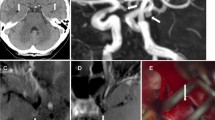Summary
A case of a ruptured aneurysm is presented in which the angiograms did not disclose the sac. Rupture of an aneurysm of the anterior communicating artery was suspected from the distribution of subarachnoid blood on computerized tomography (CT), and the presence of a sac was highly suggestive on magnetic resonance imaging (MRI), which led us to open surgery. A non-thrombosed aneurysm was discovered at the suspected site, and successfully clipped. The necessity is discussed of MRI investigation in patients with subarachnoid haemorrhage (SAH) of unknown aetiology.
Similar content being viewed by others
References
Béguelin C, Seiler R (1983) Subarachnoid haemorrhage with normal cerebral panangiography. Neurosurgery 13: 409–411
Dublin AB, French BN (1980) Cerebral aneurysmal rupture during angiography with confirmation by computed tomography: A review of intra-angiographic aneurysmal rupture. Surg Neurol 13: 19–26
Eller TW (1986) MRI demonstration of clot in a small unruptured aneurysm causing stroke. Case report. J Neurosurg 65: 411–412
Forster DMC, Steiner L, Hakanson S, Bergvall U (1978) The value of repeat panangiography in cases of unexplained subarachnoid haemorrhage. J Neurosurg 48: 712–716
Hackney DB, Lesnick JE, Zimmerman RAet al (1986) MR identification of bleeding site in subarachnoid haemorrhage with multiple intracranial aneurysms. J Comput Assist Tomogr 10: 878–880
Jenkins A, Hadley DM, Teasdale GM, Condon B, Macpherson P, Patterson J (1988) Magnetic resonance imaging of acute subarachnoid haemorrhage. J Neurosurg 68: 731–736
Locksley HB (1966) Report on the cooperative study of intracranial aneurysms and subarachnoid haemorrhage, Section V, Part 1. Natural history of subarachnoid haemorrhage, intracranial aneurysms and arteriovenous malformations. J Neurosurg 25: 219–239
Pertuiset B, Sichez JP, Arthuis F (1987) Traitement chirurgical des anévrysmes artériels sacculaires supra-clinoidiens admis dans les trois semaines suivant la rupture. Neurochirurgie 33 [Suppl 1]: 3–106
Worthington BS, Kean DM, Hawkes RCet al (1983) NMR imaging in the recognition of giant intracranial aneurysms. AJNR 4: 835–836
Wright RL (1978) Pressure considerations in carotid compression during angiography. J Neurosurg 19: 375–377
Author information
Authors and Affiliations
Additional information
We would like to emphasize the usefulness of MRI when an aneurysmal sac is suspected. Therefore, we recommend MRI be performed in patients with SAH of unknown aetiology.
Rights and permissions
About this article
Cite this article
Pertuiset, B., Haisa, T., Bordi, L. et al. Detection of a ruptured aneurysmal sac by MRI in a case of negative angiogram. Successful clipping of an anterior communicating artery aneurysm. Acta neurochir 100, 84–86 (1989). https://doi.org/10.1007/BF01405281
Issue Date:
DOI: https://doi.org/10.1007/BF01405281




